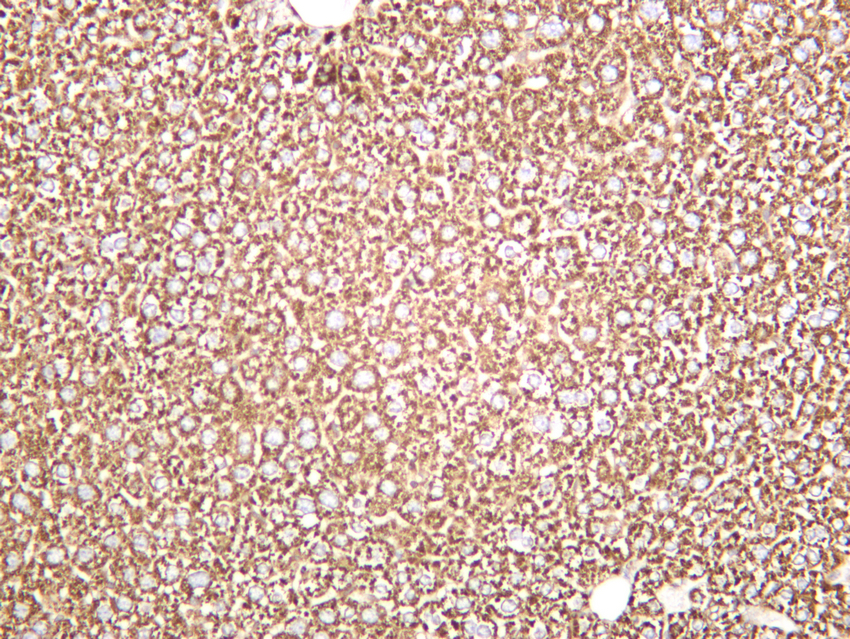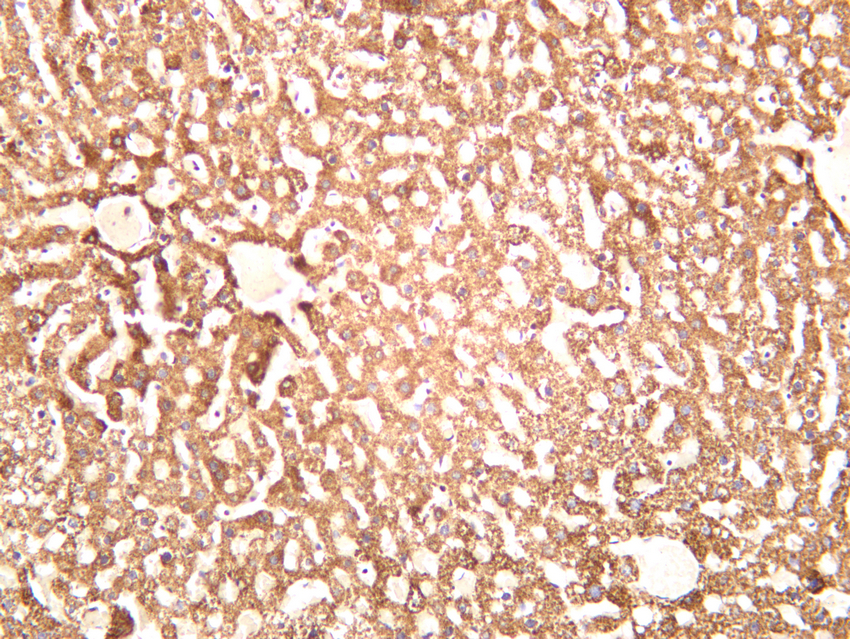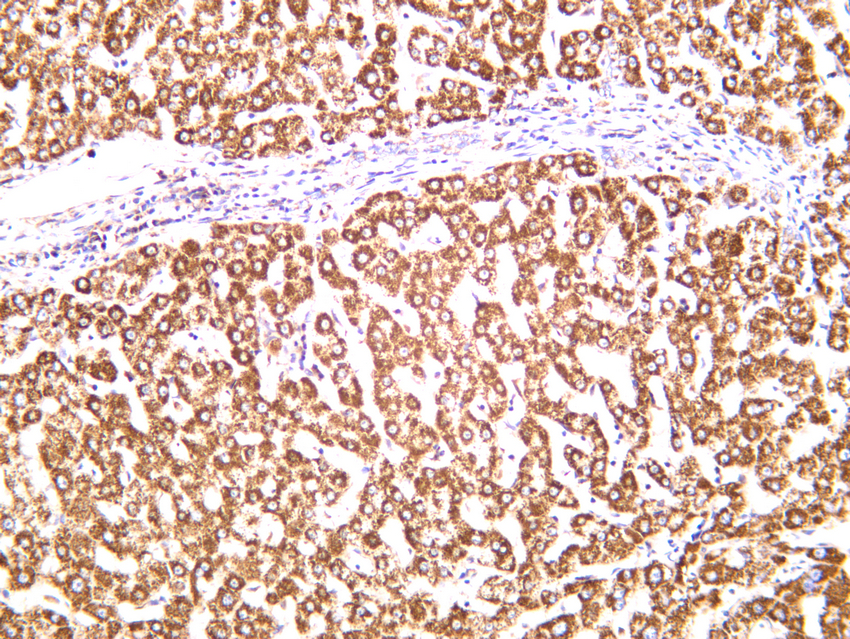Hsp60 (PT0327R) PT® Rabbit mAb
- Catalog No.:YM8193
- Applications:WB;IHC;IF;IP;ELISA
- Reactivity:Human; Mouse; Rat;
- Gene Name:
- >>RNA degradation;>>Type I diabetes mellitus;>>Legionellosis;>>Tuberculosis;>>Lipid and atherosclerosis
- Protein Name:
- HSPD1
- Sequence:
- 60 kDa heat shock protein mitochondrial
- Human Gene Id:
- 3329
- Human Swiss Prot No:
- P10809
- Mouse Gene Id:
- 15510
- Mouse Swiss Prot No:
- P63038
- Rat Gene Id:
- 63868
- Rat Swiss Prot No:
- P63039
- Specificity:
- endogenous
- Formulation:
- PBS, 50% glycerol, 0.05% Proclin 300, 0.05%BSA
- Source:
- Monoclonal, rabbit, IgG, Kappa
- Dilution:
- IHC 1:1000-1:4000,WB 1:1000-1:5000,IF 1:200-1:1000,ELISA 1:5000-1:20000,IP 1:50-1:200,
- Purification:
- Protein A
- Storage Stability:
- -15°C to -25°C/1 year(Do not lower than -25°C)
- Other Name:
- HSPD1;HSP60;60 kDa heat shock protein; mitochondrial;60 kDa chaperonin;Chaperonin 60;CPN60;Heat shock protein 60;HSP-60;Hsp60;HuCHA60;Mitochondrial matrix protein P1;P60 lymphocyte protein
- Molecular Weight(Da):
- 60kD
- Observed Band(KD):
- 60kD
- Background:
- This gene encodes a member of the chaperonin family. The encoded mitochondrial protein may function as a signaling molecule in the innate immune system. This protein is essential for the folding and assembly of newly imported proteins in the mitochondria. This gene is adjacent to a related family member and the region between the 2 genes functions as a bidirectional promoter. Several pseudogenes have been associated with this gene. Two transcript variants encoding the same protein have been identified for this gene. Mutations associated with this gene cause autosomal recessive spastic paraplegia 13. [provided by RefSeq, Jun 2010],
- Function:
- disease:Defects in HSPD1 are a cause of spastic paraplegia autosomal dominant type 13 (SPG13) [MIM:605280]. Spastic paraplegia is a degenerative spinal cord disorder characterized by a slow, gradual, progressive weakness and spasticity of the lower limbs.,disease:Defects in HSPD1 are the cause of leukodystrophy hypomyelinating type 4 (HLD4) [MIM:612233]; also called mitochondrial HSP60 chaperonopathy or MitCHAP-60 disease. HLD4 is a severe autosomal recessive hypomyelinating leukodystrophy. Clinically characterized by infantile-onset rotary nystagmus, progressive spastic paraplegia, neurologic regression, motor impairment, profound mental retardation. Death usually occurrs within the first 2 decades of life.,function:Implicated in mitochondrial protein import and macromolecular assembly. May facilitate the correct folding of imported proteins. May also prevent misfolding and promote the
- Subcellular Location:
- Mitochondrion matrix
- Expression:
- Adipocyte,Adrenal gland,B-cell lymphoma,Brain,Cajal-Retzius
Nucleus-targeting near-infrared nanoparticles based on TAT peptide-conjugated IR780 for photo-chemotherapy of breast cancer. CHEMICAL ENGINEERING JOURNAL Chem Eng J. 2020 Jan;380:122458 IF Mouse 4T1 tumor 4T1 cell
Paraquat-induced inflammatory response of microglia through HSP60/TLR4 signaling:. HUMAN & EXPERIMENTAL TOXICOLOGY Hum Exp Toxicol. 2018;37(11):1161-1168 WB Mouse BV2 cell
- June 19-2018
- WESTERN IMMUNOBLOTTING PROTOCOL
- June 19-2018
- IMMUNOHISTOCHEMISTRY-PARAFFIN PROTOCOL
- June 19-2018
- IMMUNOFLUORESCENCE PROTOCOL
- September 08-2020
- FLOW-CYTOMEYRT-PROTOCOL
- May 20-2022
- Cell-Based ELISA│解您多样本WB检测之困扰
- July 13-2018
- CELL-BASED-ELISA-PROTOCOL-FOR-ACETYL-PROTEIN
- July 13-2018
- CELL-BASED-ELISA-PROTOCOL-FOR-PHOSPHO-PROTEIN
- July 13-2018
- Antibody-FAQs
- Products Images

- Mouse liver was stained with anti-Hsp60 (PT0327R) rabbit antibody

- Rat liver was stained with anti-Hsp60 (PT0327R) rabbit antibody

- Various whole cell lysates were separated by 4-20% SDS-PAGE, and the membrane was blotted with anti-Hsp60 (PT0327R) antibody. The HRP-conjugated Goat anti-Rabbit IgG(H + L) antibody was used to detect the antibody. Lane 1: Hela Lane 2: T47D Lane 3: NIH-3T3 Lane 4: C6 Predicted band size: 60kDa Observed band size: 60kDa

- Human liver was stained with anti-Hsp60 (PT0327R) rabbit antibody



